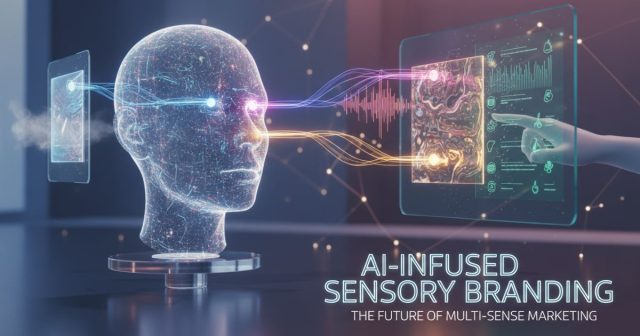Branding is evolving faster than ever. What once relied on visual logos, color palettes, and catchy slogans is now shifting toward immersive, multi-sensory brand experiences that activate all five senses. Modern consumers expect brands to not only look appealing—but to sound distinctive, feel engaging, smell memorable, and create emotional impressions that stay with them long after the interaction ends.
Artificial intelligence is at the center of this transformation. With advanced AI-driven branding tools, companies can personalize sensory elements in real time, adjusting scent, sound, lighting, texture, and visual cues based on each customer’s behavior and mood. This moves brands from static communication to dynamic, emotion-aware marketing environments that adapt naturally to user needs.
By leveraging sensory marketing technology, companies can build deeper emotional connections, strengthen brand recall, and deliver data-driven personalized experiences that traditional strategies cannot match. AI sensory branding is now the next frontier—where technology, neuroscience, and human emotion merge to create unforgettable customer moments.
Understanding AI Sensory Branding
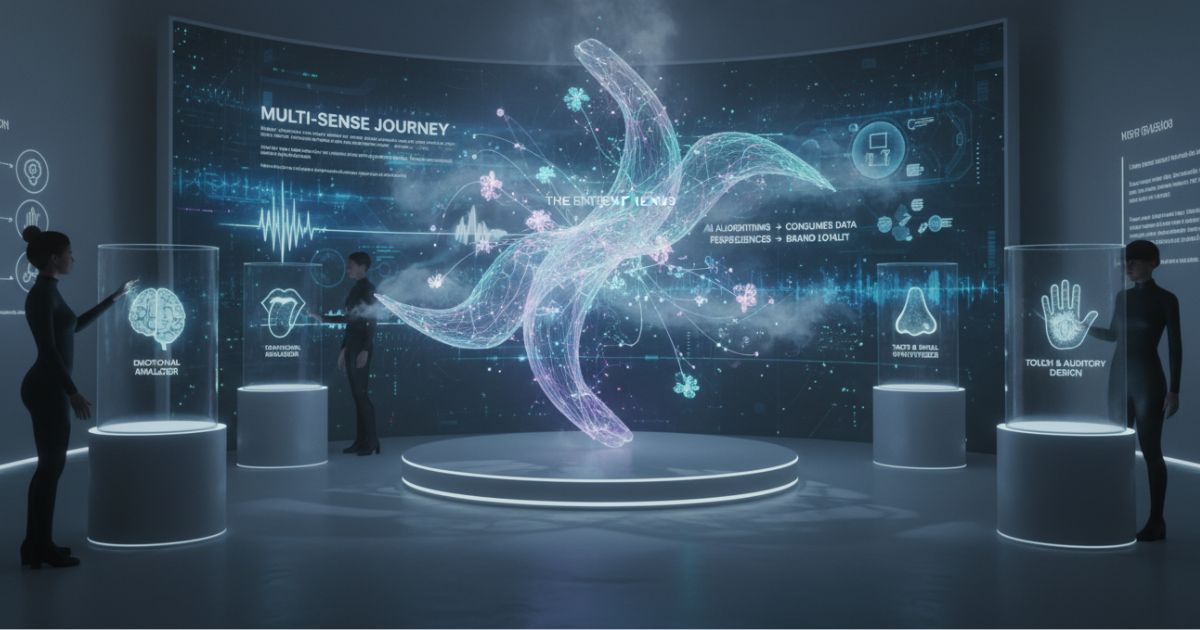
What Is Sensory Branding?
Sensory branding is a marketing approach that engages multiple human senses to create stronger and more memorable brand experiences. Instead of focusing only on visuals and sound, this strategy adds scent, touch, and taste to build richer brand associations. When customers interact with a brand through multiple senses, the experience feels more real, personal, and emotionally meaningful.
How AI Elevates Sensory Branding
Artificial intelligence takes sensory branding to the next level. AI systems analyze large amounts of customer data—such as behavior, preferences, and emotional responses—to personalize sensory experiences. Machine learning models can predict which sensory combinations will work best for different customer groups.
For example, AI can adjust:
- Lighting and color tones based on shopping behavior
- Background music based on customer mood
- Signature scents based on time of day or store traffic
- Product textures or interactive surfaces for better engagement
This level of real-time sensory personalization helps brands deliver experiences that feel natural and emotionally aligned with each customer.
The Psychology of Multi-Sensory Marketing
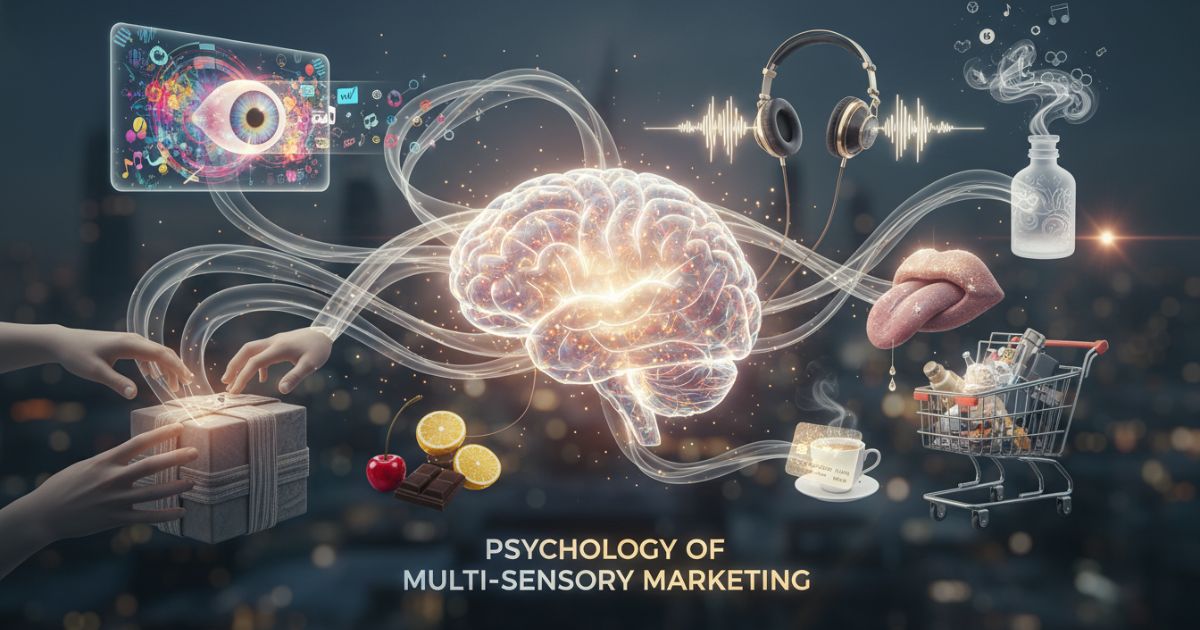
How the Brain Responds to Sensory Input
The human brain processes sensory information through connected neural pathways. When multiple senses are activated at the same time, the brain forms deeper and more durable memories. This process is called sensory binding. It explains why multi-sensory experiences feel richer and leave stronger impressions than single-sense marketing.
AI and Sensory Psychology Working Together
AI-powered marketing tools use this psychological principle to identify the best sensory combinations for specific customer profiles. For example:
- Millennials might respond well to citrus fragrances and upbeat electronic music.
- Gen X customers may prefer warm vanilla scents and classic rock soundtracks.
Instead of guessing what might work, AI uses real data—such as biometric signals, purchase history, mood indicators, and browsing patterns—to design experiences that target individual emotional triggers.
Why Data-Driven Sensory Branding Works
AI removes the limitations of traditional demographic-based marketing. Instead of treating all customers the same, AI creates personalized emotional branding strategies that adapt to each person’s preferences. This makes the brand experience more engaging, more relevant, and more memorable.
The Five Pillars of AI-Powered Sensory Experiences
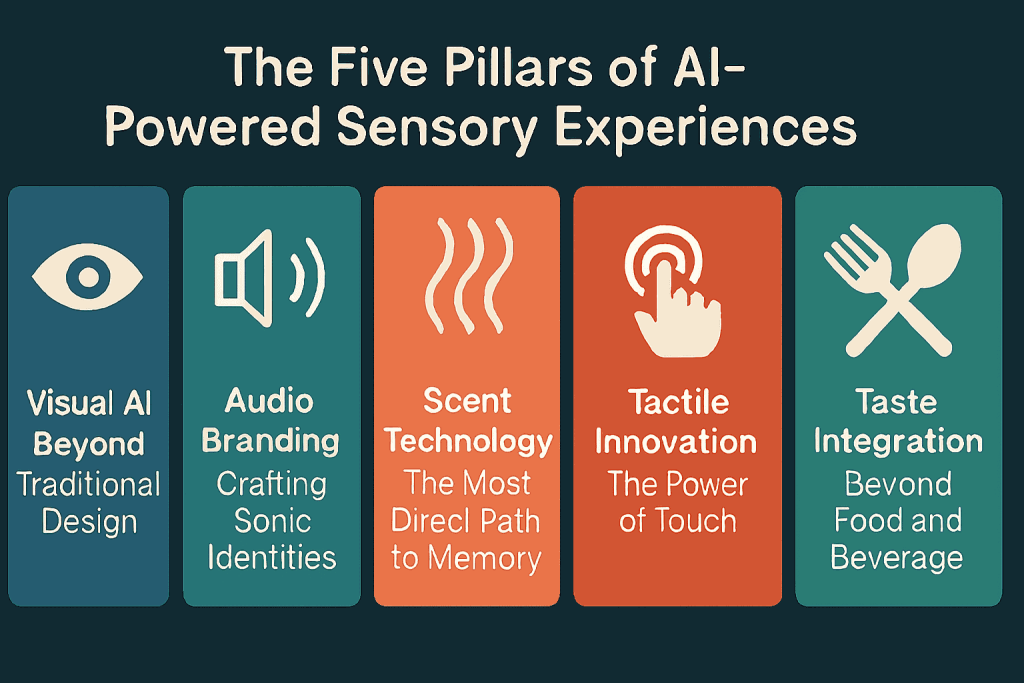
Visual AI: Beyond Traditional Design
Visual branding with AI extends far beyond static logos and color schemes. Dynamic visual systems adapt in real-time based on customer preferences, time of day, weather conditions, and emotional states detected through facial recognition technology.
Retail environments use computer vision to analyze customer gaze patterns and adjust digital displays accordingly. If AI detects that a customer lingers near eco-friendly products, the surrounding visual elements might shift to emphasize sustainability messaging through nature-inspired imagery and earth-tone color palettes.
Personalized brand storytelling through visual AI creates unique narratives for each customer journey. Fashion brands deploy AI to customize website imagery based on previous browsing behavior, presenting visuals that align with individual style preferences and aspirations.
Audio Branding: Crafting Sonic Identities
Branded soundscapes powered by AI create distinctive audio environments that reinforce brand identity while adapting to customer preferences. These systems analyze ambient noise levels, customer demographics, and behavioral data to optimize music selection, volume, and audio branding elements.
Restaurants use AI to adjust background music based on dining patterns and customer feedback. During busy lunch periods, the system might select energetic tracks to encourage faster turnover, while evening diners hear relaxed melodies that promote longer stays and higher spending.
AI-powered voice assistants are becoming brand ambassadors with carefully crafted vocal characteristics. Companies invest in developing unique voice profiles that reflect brand personality, from friendly and approachable to sophisticated and authoritative.
Scent Technology: The Most Direct Path to Memory
Scent marketing technology represents one of the most powerful applications of AI in branding. The human olfactory system connects directly to the limbic brain, where emotions and memories are processed, making scent the fastest route to emotional response.
AI systems control scent diffusion based on customer traffic patterns, weather conditions, and seasonal preferences. Luxury hotels deploy smart scent systems that release signature fragrances when VIP guests enter the lobby, creating personalized welcome experiences.
Retail stores use AI to optimize scent intensity throughout the day. Morning shoppers might experience energizing citrus scents, while evening customers encounter relaxing lavender notes that encourage leisurely browsing and increased purchase consideration.
Tactile Innovation: The Power of Touch
Tactile brand experiences engage the sense of touch through textures, temperatures, and materials. AI enhances these experiences by personalizing tactile elements based on customer preferences and physiological responses.
Technology showrooms use haptic feedback systems that adapt to individual users. When customers handle display products, AI analyzes their touch patterns and pressure preferences to customize the tactile feedback, creating more engaging product demonstrations.
Smart retail environments adjust ambient temperature and humidity based on customer comfort preferences detected through wearable devices or mobile apps. This subtle personalization creates more comfortable shopping environments that encourage longer visits.
Taste Integration: Beyond Food and Beverage
While taste might seem limited to food and beverage brands, AI-powered customer engagement expands gustatory experiences across industries. Beauty brands offer personalized lip balm flavors, while automotive companies provide customized air fresheners that complement their brand identity.
Coffee shops use AI to recommend flavor profiles based on previous orders, weather conditions, and time of day. These systems learn individual taste preferences and suggest new combinations that align with personal flavor journeys.
Implementing AI-Driven Sensory Campaigns
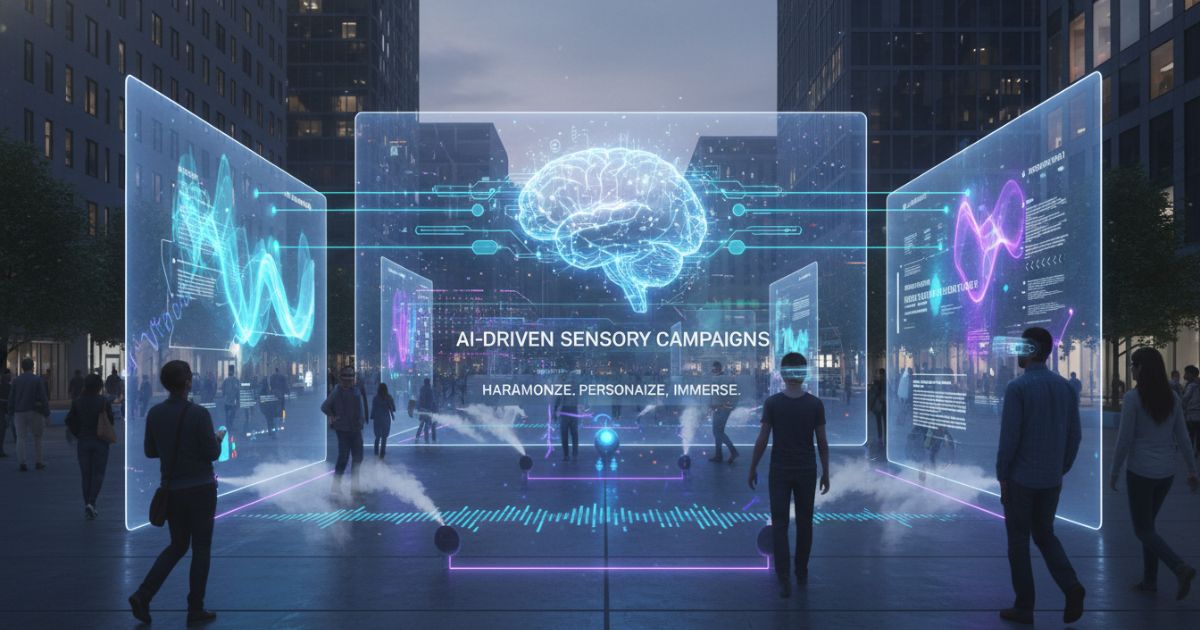
1. Data Collection and Analysis
Gathering the Right Customer Insights
Every successful AI sensory marketing campaign starts with strong data. Brands must collect information from multiple touchpoints, including purchase history, browsing behavior, dwell time, biometric signals, and direct customer feedback. These data sources help AI systems understand what customers enjoy, what influences their emotions, and which sensory elements drive engagement.
Building Trust Through Ethical Data Practices
Because sensory data can be sensitive, privacy and transparency are essential. Clear opt-in options and honest data usage explanations help customers feel comfortable sharing their sensory preferences. When customers understand the value they will receive—such as personalized experiences—they are more willing to participate.
Using Neurobranding for Deeper Emotional Insights
AI becomes even more powerful when paired with neurobranding techniques. Tools like EEG monitoring, eye tracking, and facial expression analysis reveal genuine emotional reactions to lighting, scent, sound, and texture. This data gives brands a clearer picture of what truly resonates, allowing them to optimize sensory campaigns with accuracy and confidence.
2. Technology Infrastructure
Building the Foundation for AI-Infused Sensory Branding
Implementing sensory branding supported by AI requires a strong technology ecosystem. IoT sensors track environmental conditions, customer movement, and how sensory devices perform. Cloud-based AI platforms process this data instantly and adjust sensory elements in real time.
Connected Environments for Adaptive Brand Experiences
Modern smart building systems integrate lighting, audio, scent diffusion, and climate control into one unified structure. AI manages these systems based on customer preferences, foot traffic patterns, and brand goals. The result is consistent, adaptive sensory environments that strengthen emotional engagement.
Extending Sensory Branding to Mobile
Sensory branding is not limited to physical spaces. Mobile apps can extend these experiences with:
- Personalized audio cues
- Reminder scents connected to brand moments
- Product suggestions based on previous sensory interactions
This creates an always-on multi-sensory experience that continues beyond the store or event.
3. Measuring Success and ROI
Tracking What Truly Matters
Modern experiential marketing focuses on measurable outcomes. AI-powered analytics track:
- Customer engagement levels
- Emotional responses
- Time spent in sensory zones
- Conversion rates linked to specific sensory combinations
These insights show which elements are working and which need refinement.
AI-Enhanced A/B Testing for Sensory Variables
AI allows brands to test hundreds of sensory variations at once—different scents, lighting temperatures, soundtracks, textures, or product arrangements. This advanced testing identifies the best combinations for each segment or environment, making optimization continuous and data-driven.
Long-Term Value and Brand Loyalty
The strongest ROI comes from long-term emotional loyalty. Multi-sensory experiences increase customer lifetime value, brand recall, and repeat purchase behavior. When customers associate a brand with meaningful sensory moments, they stay connected for years.
Case Studies: Brands Leading the Sensory Revolution
Luxury Retail: Personalized Shopping Journeys
A leading luxury fashion retailer implemented AI-powered sensory branding across their flagship stores. The system recognizes returning customers through facial recognition and immediately adjusts lighting temperature, background music, and subtle scent diffusion based on previous shopping preferences.
Customer data revealed that successful purchases correlated with specific sensory combinations. The AI system learned that customers who eventually made high-value purchases responded positively to warm lighting, classical music, and light floral scents during their browsing phase.
Results included a 34% increase in average transaction value and a 28% improvement in customer satisfaction scores. Most significantly, customer return visit frequency increased by 45%, indicating stronger emotional connections to the brand experience.
Hospitality: Emotional Journey Mapping
A luxury hotel chain developed AI systems that create personalized sensory journeys from arrival through departure. The technology analyzes guest preferences, booking patterns, and real-time biometric data to optimize every sensory touchpoint.
Upon check-in, the system adjusts room temperature, lighting color, and background audio based on guest preferences and circadian rhythm optimization. Bathroom amenities release personalized scent profiles, while in-room dining recommendations align with taste preferences learned from previous stays.
Guest satisfaction scores improved by 31%, with specific praise for the “intuitive” and “thoughtful” nature of their stays. Revenue per available room increased by 22% as guests extended their stays and booked return visits at higher rates.
Automotive: Multi-Sensory Showrooms
An automotive manufacturer transformed their showroom experience using AI-powered sensory branding. The system creates different atmospheric zones that align with various vehicle categories and customer personas.
Electric vehicle displays feature clean, crisp scents and ambient sounds that reinforce sustainability messaging. Luxury car sections employ rich leather aromas and sophisticated audio environments. Sports car areas pulse with energetic music and invigorating scents that evoke excitement and performance.
Customer engagement metrics showed 52% longer showroom visits and 38% higher test drive conversion rates. Sales representatives reported that customers seemed more emotionally connected to vehicles, leading to easier closing processes and higher option package attachment rates.
Overcoming Implementation Challenges
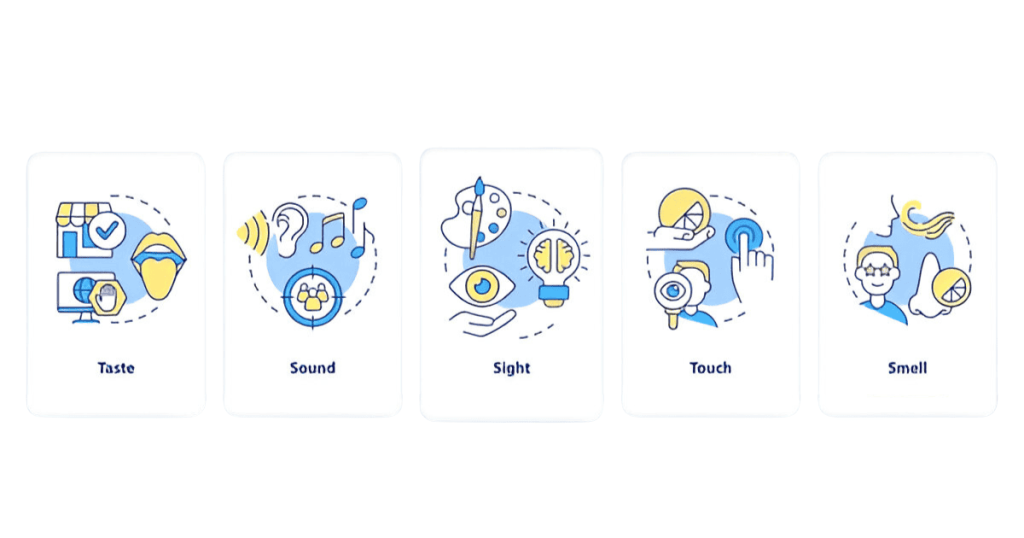
1. Privacy and Ethical Considerations
Managing Sensitive Customer Data
AI-driven sensory branding often relies on biometric signals, behavioral patterns, and emotional response data. Because these insights are highly sensitive, brands must prioritize data protection, transparent communication, and ethical data usage. Secure storage, encryption, and strict access controls help maintain customer trust.
Clear and Accessible Opt-Out Options
Customers should always know how their sensory preference data is collected and why it’s needed. Simple opt-in and opt-out mechanisms allow users to stay in control of their experience. When customers feel respected and informed, participation rates increase—resulting in more accurate personalization and stronger customer relationships.
Cultural Sensitivity Across Global Markets
Sensory preferences vary widely across cultures.
Examples include:
- Certain scents being comforting in one region but overwhelming in another
- Colors carrying different emotional meanings
- Music genres resonating differently with various age groups
AI systems must be trained on diverse datasets to avoid cultural bias and deliver relevant sensory experiences in global markets.
2. Technology Integration Complexity
Upgrading Legacy Systems
Integrating multi-sensory devices, IoT sensors, and AI management platforms can be challenging. Many organizations still rely on older systems that cannot support real-time sensory adjustments. Upgrading infrastructure ensures smoother automation, better data flow, and more accurate sensory optimization.
Training Teams for New Experiences
Staff training is essential for successful implementation. Employees must understand how AI-powered sensory tools work, how to interpret system insights, and when manual adjustments are needed to maintain brand consistency. Trained teams create smoother customer experiences and reduce operational errors.
Ongoing Maintenance and Sensory Calibration
To deliver consistent sensory branding, regular maintenance is required:
- Scent diffusers must be refilled and cleaned
- Audio systems need periodic acoustic balancing
- Lighting and digital displays require color calibration
- Interactive surfaces and tactile elements need inspection
Continuous calibration ensures that every sensory touchpoint matches the brand’s intended mood and quality.
3. Cost-Benefit Analysis
Evaluating Investments in AI and Sensory Technology
AI-driven sensory branding requires substantial investment in hardware, software, and training. While initial costs may be high, brands must consider the long-term benefits. Sensory personalization boosts emotional engagement, influences buying decisions, and strengthens brand loyalty.
Starting Small With Phased Implementation
A step-by-step rollout helps brands minimize financial risk.
Examples include:
- Testing sensory experiences in one flagship store
- Running controlled pilots for scent or sound personalization
- Evaluating AI-driven adjustments during specific time periods
These pilot programs offer valuable insights before a full-scale rollout.
Focusing on Long-Term ROI
The real value of sensory branding is not only immediate sales. It significantly improves:
- Customer lifetime value
- Repeat purchase rates
- Brand loyalty
- Emotional connection
- Differentiation in saturated markets
Brands that invest early in multi-sensory AI experiences often see long-term competitive advantages that justify the initial cost.
The Future of AI and Sensory Marketing

Emerging Technologies
AI is opening new possibilities in how brands design and deliver sensory experiences. Virtual and augmented reality platforms now let companies build immersive experiences that strengthen brand identity beyond physical locations. These AI-powered environments support deeper emotional engagement and help brands stand out in the era of experiential branding.
Haptic technology is also evolving rapidly. Future innovations may allow customers to feel product textures through mobile devices or wearables. This shift brings a new dimension to multisensory marketing, making product interaction more realistic and intuitive.
Biometric data will play a major role as wearable technology becomes more common. AI systems will access real-time emotional and physiological signals, offering powerful customer engagement intelligence. Combined with neurobranding insights, brands will be able to refine sensory experiences with exceptional accuracy.
Predictive Personalization
AI will make sensory marketing smarter and more proactive. Machine learning algorithms will predict the best sensory combinations for each customer—even when data is limited. This helps brands deliver personalized experiences from the very first interaction.
AI will also enhance contextual personalization. Sensory elements will adapt automatically based on weather, time of day, environmental conditions, or cultural moments. These dynamic adjustments make brand interactions feel more natural and meaningful.
Consistency across all platforms will become essential. Brands will use AI sensory branding to ensure that visual, audio, scent, and haptic cues stay aligned whether customers shop online, visit a store, or explore a mobile app. This cross-platform coherence strengthens emotional connection and improves long-term brand loyalty.
Transforming Brand Relationships Through Sensory AI
AI-driven sensory branding is changing how brands build relationships with customers. Instead of relying on traditional marketing tactics, companies are shifting toward deeper, immersive experiences that feel personal and meaningful. When AI enhances these sensory touchpoints, brands move from simple transactions to emotional connections that last longer.
Modern technology already makes this possible. AI can personalize scent, sound, visuals, and even touch to create multisensory interactions that feel unique to each customer. These experiences strengthen loyalty because they tap into how the human brain forms memory and emotion. Brands using this approach early are gaining a clear competitive advantage as customer expectations continue to evolve.
But real success requires strategy. Brands must invest in the right systems, understand customer behavior, and apply psychological and neurobranding insights effectively. When AI analyzes subtle emotional cues and behavior patterns, it helps brands deliver experiences that align with genuine customer needs — not broad assumptions.
The future belongs to brands that can create consistent, intuitive, and emotionally rich experiences across every touchpoint. With AI enabling smarter contextual personalization, sensory branding will become a natural part of how customers connect with brands. The question now is not whether this shift will happen, but which brands will lead it and build the strongest emotional bonds.
FAQs
1. What is AI sensory branding and how does it work?
AI sensory branding is the use of artificial intelligence to personalize sensory elements such as visuals, sound, scent, touch, and even taste. AI systems analyze customer data—like behavior, mood, and preferences—and adjust sensory experiences in real time. This creates deeper emotional engagement and more memorable brand interactions.
2. Why is multi-sensory marketing important for modern brands?
Multi-sensory marketing activates multiple human senses at once, which helps customers form stronger emotional and memory-based connections. Research shows that multi-sense experiences increase brand recall, influence buying decisions, and improve overall customer satisfaction. With AI, these experiences become even more personalized and impactful.
3. Can AI really personalize sensory experiences for individual customers?
Yes. AI can personalize sensory experiences by analyzing browsing behavior, purchase history, emotional cues, and contextual factors such as time of day or store traffic. It can adjust music, lighting, scent intensity, visual displays, and even tactile elements automatically to match each customer’s preferences.
4. What industries benefit the most from AI-powered sensory branding?
Industries with physical or experiential touchpoints gain the most value. These include retail, hospitality, automotive, wellness, beauty, food & beverage, entertainment, and luxury sectors. However, digital platforms also benefit through personalized audio, visuals, haptics, and adaptive UI elements powered by AI.
5. Is AI sensory branding expensive to implement?
The cost depends on scale, but brands often see strong long-term ROI. Investments include AI software, IoT sensors, scent diffusers, smart lighting, sound systems, and staff training. Many companies start with small pilot programs in one store or customer zone before scaling. Most brands report higher engagement, better conversion rates, and stronger loyalty after implementation.

